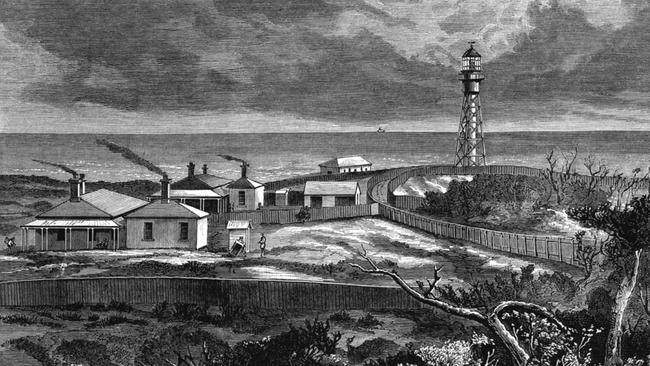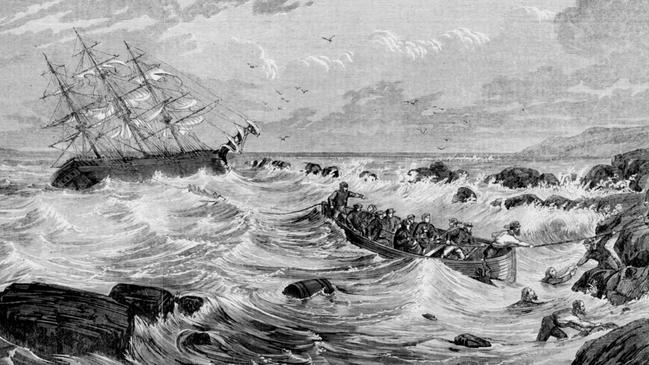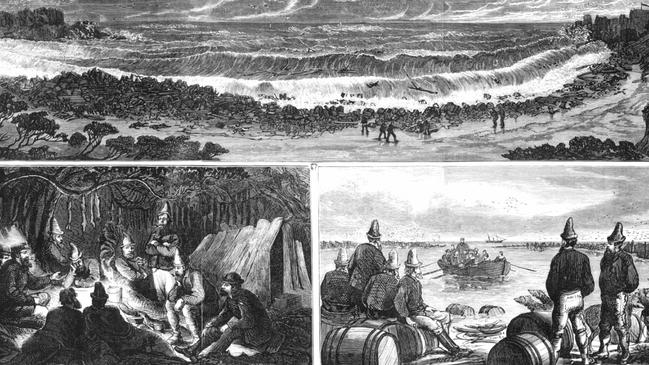The foggy history of pirates and killers on Bass Strait
Escaped convicts who lit bonfires to lure ships onto rocks. Pirates who sliced off the fingers of their victims to steal their jewels. These are the tales an old seafarer told a Melbourne journalist, but the history of pirates on Bass Strait remains foggy.

Lifestyle
Don't miss out on the headlines from Lifestyle. Followed categories will be added to My News.
As bad weather brewed around King Island, a small boy hid in a milking shed and listened to two rough men talking.
Daring not to make a noise, the boy knew these men were killers.
They were discussing the division of plunder from a shipwreck on the island; who should get what and where they should keep it.
After talking at length, the pirates finally left.
They went to sea and the boy never saw them or heard about them again. He guessed they perished on the waves.
It was the mid Nineteenth Century and the boy, Charles Winter, would grow up to lead a long and adventurous life at sea on Bass Strait.
When he retired to Melbourne, a journalist visited his home on Commercial Rd in 1921 where the then 72-year-old Winter told colourful stories about the pirates of the Strait.

These nasty men would light bonfires to imitate lighthouses and confuse ships in fog, luring them to the rocks where they would break up.
Murderers and kidnappers, those godless pirates would spot gold jewels on the hands on the hapless wreck victims, and would simply cut the fingers off to claim their prize.
That’s according to Winter.
Despite the old sea stories, the historical presence of pirates on Bass Strait remains foggy.
RUNAWAYS
A Hobart news article from 1826, four years before the foundation of Melbourne, read “These islands are, without exception, inhabited by runaways from this and the elder colony”, who had formed “a dangerous and increasing band of pirates.”
Escaped convicts used the cover of darkness to steal boats and escape in small gangs down the river and into the open sea.
Those who slipped past guard vessels stopped at any port they could find, stealing anything lying about and slipping away again.
The towns at Oyster Bay and Swan Port were especially affected by the pirates, who were believed to live off wallabies and other wildlife they found on the Bass Strait islands.
It was guessed that half of them died at sea.
By the time Charles Winter was a boy in the mid Nineteenth Century, the pirates, according to his account, had become wreckers who lured ships to their doom on rocks to steal cargo.
He said of the Bass Strait pirates: “They used to build bonfires on King Island to mislead the ships in the fog, and many a good ship have I seen come ashore on the rocks in a heavy gale, and with mountainous seas running.

“The pirates hid all their loot at Robbin’s Island, and when I was a boy I remember seeing nineteen boats there which had been taken from various ships, together with scores of cutlasses, pistols, knives, and blunderbusses.”
Describing one vessel that fell victim to the wreckers, he said: “The body of a richly-dressed woman was washed up on shore next morning, and one of the wreckers, observing the diamond rings on her fingers, chopped the fingers off so as to obtain the jewellery with the least possible trouble.”
His stories of other wrecks were just as fantastic.
When he was about 18 years old a ship called Rose Ann hit the Conical Rocks near Circular Head on norther-western Tasmania and Winter claimed he was the sole survivor when he jumped overboard, swam through dangerous surf and made it to land.
Then, so he claimed, he spent ten days roaming the wilderness eating fauna including Tasmanian tigers.
TALL TALES FROM THE BASS STRAIT TRIANGLE
But the eyewitness account from the old salt in 1921, although chilling and romantic, does not match up with records.
Charles Winter’s tale about his miraculous survival from the Rose Ann struggles to hold water.
Tasmanian shipwreck records show a vessel named Rose Ann did indeed strike rocks on the island’s west coast in March 1867, when Charles Winter would have been about 18 years old.
But the record also states the ship got into trouble when the wind died and caused her to drift and the crew was rescued.
It is unlikely Winter was not the lone survivor as he later claimed.
His account of another wreck, the ship George Marshall, however, was likely accurate.
The ship’s captain John Davison later told the Launceston Marine Board that heavy fog had impeded visibility and the course had become confused by irregular tides.
When the hull struck rocks and began to sink gradually, Captain Davison made the decision to beach the ship and evacuate the crew and passengers.

He mentioned nothing about pirates.
But the ship’s chief officer made a statement that the vessel in heavy fog had strayed much closer to shore than he had realised, partly due to the fact that he did not see the light signal at any point, even when fog was thin.
It leaves open the possibility that the George Marshall’s beaching was an attempt at piracy through signal tampering.
The cause of many similar shipwrecks in the Nineteenth Century remains blurry.
In the period from 1838 until 1840, seven vessels went missing in Bass Strait – wrecked with no survivors and no explanation.
Fragments of some washed up on shore, others vanished without a trace.
The temperamental weather and changeable airconditions, and the 1978 disappearance of an aircraft piloted by Frederick Valentich led to the nickname the Bass Strait Triangle.
Tall tales of pirates and wreckers in the waters have since been dismissed as baseless.
But the truth behind the strange disappearances and the chilling tales of old sailor Charles Winter will never be known.
READ MORE:
THE MAN TO BLAME FOR RABBIT INFESTATION
